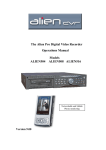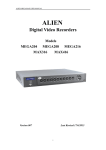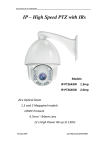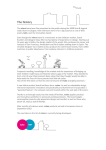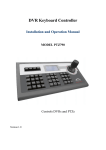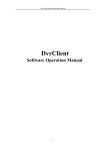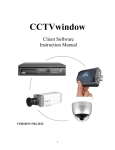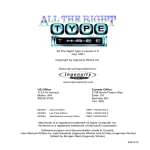Download CCTVwindow
Transcript
CCTVwindow Client Software Instruction Manual VERSION 3.02SW Contents Page 1. General Information 1.2 Computer System Requirements 1.3 Conventions 4 4 4 2. Software Installation 2.1 Installing the Software 22. Uninstall Software 4 4 4 3. Basic Operations 3.1 Login 3.2 Graphic User Interface (GUI) Introduction 5 5 6 4. Device Management 4.1 Area Configuration 4.2 Add Device 4.3 Channel Configuration 4.4 Channel Configuration for DVR9K series 4.5 Group Configuration 4.6 Sort by Camera Configuration 9 10 11 13 14 16 18 5. Preview 5.1 Non-cycle Preview 5.2 Cycle Play (Sequencing) 5.3 Preview Control 5.4 Recording & Capture 5.5 Others 19 20 21 24 25 27 6. PTZ Control 6.1 RS485 Parameter Configuration 6.2 PTZ Control 6.3 Presets 6.4 Patrol 6.5 Video Parameters Configuration 30 30 30 31 31 33 7. Recording 7.1 Client Local Recording 7.2 NVR Storage Server Recording Configuration 34 34 34 8. Playback 8.1 Remote VOD 8.2 Local Playback 8.3 Event Playback 37 37 41 43 2 9. Remote Configuration 9.1 Remote Recording Configuration 9.2 Alarm 9.3 Network Configuration 9.4 Network Configuration 9.5 Account Management 9.6 Others 45 46 51 57 59 60 61 10. Alarm Linkage 10.1 Linkage Configuration 10.2 On Arm & Off Arm 63 63 64 11. E-Map 11.1 Add Map 11.2 Map Configuration 66 66 67 12. Utilities 12.1 Software Configuration 12.2 Log Management 12.3 User Management 70 70 71 74 3 1. General Information 1.1 Overview The CCTVwindow client is applicable to all Alien DVRs, the DVR9K, IP Traditional Cameras, IP Dome Cameras and the Video Bridge. 1.2 Computer System Requirements · · · · 1.3 Operating System: CPU: RAM: Display: Microsoft Windows 2000 or versions above Intel Pentium IV 2.4 GHz or models above 1Gb or above 1024×768 or above, minimum 16 bit colour Conventions The following conventions are used in this manual: · DVR, IP Camera, IP Dome and Video Bridge are all referred to as a ‘device’ · Click refers to clicking the left hand mouse button · Double click refers to double clicking the left hand mouse button 2. Software Installation 2.1 Installing the Software Double click the software and you will see the wizard shown. Click “Next”to continue and input the user information and software installed location. After that, an SADP installation wizard will pop up. Now click “Next”to start to install WinPcap. If it is already installed, the installation can be cancelled. Note: SADP (Scoped Address Discovery Protocol) is used as the on-line device finder. This function is unavailable if the WinPcap is not installed. SADP discovers the IP address of a device without knowing the address or subnet mask. 2.2 Uninstall Software This software must be removed via Control Panel, Add/Remove Programs. Locate and highlight ‘CCTVWindow’and click ‘Remove’. Confirm the removal and allow the Installer to remove the application. WinPCAP, if installed during the installation process must be removed manually –there is a separate item for this in Add/Remove programs as well. 4 3. Basic Operations 3.1 Login This software has been set with a User of admin and a password of 123456 When the software is initiated if the Automatic Login is ticked the username and password will be automatically retained and there will be no necessity to enter the username or password when logging in next time. If the user wishes to change the password, then select a username and click Modify. If the username or password is incorrect the following dialogue box will be displayed as shown below. If the user wants to cancel the login, then click Quit. SPECIAL NOTE: Please stop all operations (e.g preview, recording, playback etc.) before switching users. 5 3.2 Graphic User Interface (GUI) Introduction There are 6 client software GUI areas as shown below. 1 2 3 4 5 6 1. System Area: If you minimise the software by clicking on the –(minimise button), if you right click the icon at the bottom of the taskbar Preview, Setup, Remote VOD, Local Playback, Event Playback, Map, Log and Exit can be selected. 6 2. Menu Area: 3. Device Area: 4. Preview Area: 1 2 3 7 4 5. PTZ Control Area PTZ Control PTZ Preset Configure and call presets Tours Configure and call tours Image Brightness, Contrast, Saturation, Hue and Volume adjustment. 6. Alarm Info Area Display alarm time, information and alarm sign. The area size can be enlarged by dragging the top of the area upwards. You can fix the area size by clicking on icon which turns to but when it returns to resume to its original size. 8 the area size will 4. Device Management Before any operation of this software a device needs to be configured in the menu. By default a device called “DVR9K”is always set. As this software is used for DVRs, IP cameras, IP Domes and Video Servers you may prefer to use a different device name. You may use this device name, remove it and add another name that maybe more applicable or create an additional device. Click on Setup to enter configure mode and then click on Device Management. 2 1 3 9 4 4.1 Area Configuration The software can be used to access various devices over a network and to allow for places to be created as reference points for different devices. These reference points are called areas. The default area is set as UK with a DVR9K. If you right click on the World icon and select Delete Node the default settings will be deleted. If you now right click in Area 1 you will see the following box displayed: If you now left click on Add Area the following box will be displayed. Enter the required Area name e.g UK, World, Town name etc. The first area created will only allow the Area Name box to be completed, but if you for instance have set an area name of UK and then set another area say Chesterfield by clicking on the UK icon, it will display Chesterfield in the Area Name and UK in the Upper Area Name. NOTE: The following are invalid in the Area Name :- Enter, Space, Tab, null, % and “ The maximum number of areas that can be entered is 50 areas. When you select Delete Node, the sub areas, stream media servers and devices under the root of the area will be deleted as well. Before attempting this you must stop preview or record, otherwise a warning information box will be displayed. 10 4.2 Add Device Right click the Area and the following box will be displayed: Left click on the Add Device option and the following box will be displayed: 11 Normal IP mode The default register mode is the Normal IP. After input the IP address, username, password, port and channel No. Click the “OK”button to finish adding device. Normal Domain mode If you select normal domain, please fill in the blank domain name with the registered domain name. Private domain: If you configured the device with the address of IP Server that runs normally, then the connected device can be resolved by IP Server; and the software can get the dynamic IP address from IP Server by server name or serial number. Private Domain mode If you select private domain, please input the correct device serial number and IP address of IP server in the DNS Address blank. 12 Note: When adopting a private domain, if you input device serial number, the software will obtain the IP address from the IP server; If not, the IP address can be obtained by using device name to resolve IP server, i.e. in that case, the device name here should be the same with the one in the device. Click OK to finish adding device. Right-click menu is available, double click the node can modify the device parameters. Note: 50 devices can be added here. 4.3 Channel Configuration Click on Get Channel Name to get the names of all channels. 13 Double click the channel name and the Modify Channel Information dialogue box will be displayed. Note that Main Stream is for device encoding and Sub Stream is for network transmission. NOTE: The channel name will be replaced with the name saved in the device, if the option Get Channel Name is selected. 4.4 Channel Configuration for DVR9K series If this software is used with the DVR9K series then the IP channel management and enable or disable analogue channel functions are available. Right click the device name and select “Remote Configuration”, then the “Channel Configure” menu will pop up. The “Analogue Camera”will show by default. Double click the selected analogue channel to enable or disable it. Note: The DVR9K series cannot preview and record this channel after it is disabled, unless it is enabled again. 14 Click “IP camera”to enter the interface of IP channel management. Click “Add”to add IP channel. Input the IP address, user name, password and port, and then click “OK”. Double click the selected channel to modify the parameters. Click “Delete”to delete the selected channel. After that, you can change the channel number according to the added channels. Double click the device name to modify the device information. Note: The DVR9K Hybrid supports adding of up to16 analogue channels and 8 IP channels but please refer to the User Instruction Manual for more details. 15 After that, the added IP channel will be seen in the channel list of the device. If IP channel cannot be connected, the icon will be shown as 4.5 Group Configuration Click the Sort by group button to enter group area management window. 4.5.1 Sort by group There is the default group. You can add channels in it or delete it. Right click in the empty area and you will see sub menu as shown on the right. Select “Add Group”. Input the group name and click “OK”. 16 Double click the group name to change the group name. Right click the group name and select “Delete Group”to delete the selected group. Note: Enter, Space, TAB is invalid in the group name, which cannot be null, and should not contain the following characters, including % and ’. 4.5.2 Channel After adding the group, the channels in the list area can be moved to selected group. Channel Add Select the channel from the list area, and click key and move it to the selected group. The type of channel name in the group area is as “device name channel name of the list area”. Select the device in the list area and click device can be moved to the selected group. key and all the channels of the 17 Using and keys to adjust the channel sequence in the group list. Channel delete Use key to delete the channel or group in the group area. Note: One channel can be added to one group only once. Different groups can contain the same channel. Max 50 channels can be added to one group. 4.6 Sort by Camera Configuration Click Sort by camera button to enter short key management window. Only the channels can be added to the sort by camera area. Select the channel from the list area, and click key and move it to the sort by camera area. The type of channel name in the group area is as “device name channel name of the list area”. Select the device from the list area, and click key to add all the channels of the device to the sort by camera area. Use key to delete the channel in the sort by camera area. 18 5. Preview After configuring the device, double click the key to return to the preview interface. Click the “List”and “Group”keys to switch between two modes. Click key and then key and enter “Advanced Configuration”and enable button to option to save current preview state including window division and preview channel for next login. Play windows are divided into 2×2 mode, max support 64 window divisions. Stop Cycling Window Division Play Record Capture Multi-screen 19 Previous/Next Page Resume Cycling Note: The window division and channel sequence can be remembered by the Client Software on exit and will play automatically after login next time. 5.1 Non-cycle Preview 5.1.1 Play by Node Double click the device name or drag it to the play window to preview (not enable cycle preview) Double click the channel name to preview the corresponding cameras. Double click the device name to preview the corresponding cameras of the device in the current window divisions. Double click the group name to preview the corresponding cameras of the group in the current window divisions. You can also preview them by dragging them to the play windows. The play window shows as the figure on the right. 5.1.2 Sort by camera Preview Sort by camera mode In the device list mode if the sort by camera has been configured, press button of the preview interface to view all the corresponding channels in the sort by camera area in the current window divisions. If the channel number is larger than the window division number, user can click and to change the page to preview. Find more details at 4.6 Sort by Camera Configuration. 20 Sort by group mode Click the “Sort by group”to go to this mode, if the sort by group has been configured, then press button in the preview interface to view all the corresponding channels in the sort by camera area in the current window divisions. If the channel number is larger than the window division number, user can click and to change the page to preview. Find more details at 4.5 Sort by group Configuration. 5.1.3 Stop Playing There are 3 ways to stop live preview. Double click the channel to stop playing. The play icon is so double click it to stop previewing this channel and the icon will then become Right click video to stop playing Right click in the play window and the play menu will display. Click “Stop Play”and the live view will stop. Meanwhile the play icon will become Stop all playing Click the key in the preview panel to stop all the live view channels. 5.2 Cycle Play (Sequencing) 5.2.1 Cycle Configuration Click key to enter the configuration interface. Then enter the local configuration by clicking “Software Configuration”key. 21 Enable Cycle: Tick Cycle Play and input the cycle time, then press “Save”and return to preview interface. Note: Cycle time should be between 20 and 300 seconds. Disable Cycle: Click to disable Cycle Play and save. 5.2.2 Cycle Play of Device/Group Start cycle Double click the device name and all the channels of the device begin to cycle in the selected window division from the 1st channel. Double click the group name and all the channels of the group begin to cycle in the selected window division from the 1st channel. Drag the node of the device to the window, and then all the channels of this device begin to cycle. Drag the node of the group to the window, and then all the channels of this group begin to cycle. Pause/Resume Cycle If the current window is in the device/group cycle mode, right click the cycling window, click “Pause cycle device”or “Stop cycle group”to pause cycling to retain the current image. Click “Pause cycle”key to pause all the cycling window divisions. 22 If the current window is in the device/group cycle mode, right click the paused window, click “Resume cycle device”to restart cycling. Click “Resume cycle devices”key to restart all the paused channels. 5.2.3 Mixed Cycle Mixed cycle mode enables the software to sequence preview channels by group or sort by camera. The default window division is 2×2. Sequence Sort by camera Channels Click “List”key to display channel list. Click key to start mixed cycle play. Take 2×2 window division for example, if there are 8 channels in the sort key area, then start cycle playing, the first 4 channels will be displayed in the window, then after one cycle period, the last 4 channels will be displayed in the window. Click button in the preview panel to stop sequencing. Click channels. key to display the first 4 channels, click key to display the last 4 Note: Click button or to pause the channel sequence cycle of sort by camera. This function needs sort by camera configuration first. Sequence Group Channels Click “Sort by group”key to display group channel list. (Please stop playing before switching to group channels.) Click key to start mixed cycle play. Take a 2×2 window division for example. If there are 2 groups in sort by group area and each of them has 4 channels, then start cycle playing and 4 channels of the first group will be displayed in the window. After one cycle period, 4 channels of the second group will be displayed in the window. 23 Click channels. key to display the first 4 channels or click key to display the last 4 Note: Click button or to pause the channel sequence cycle of sort by group. This function needs sort by group configuration first. 5.3 Preview Control Full Screen: When previewing, click key to preview in full screen or to exit click key. Enlarge: When in the multi-screen preview mode, double click the selected image to enlarge it or double click again to resume. Main/Sub Stream: Main stream is for recording and sub stream is for network transmission when bandwidth is low. The stream will take effect after re-previewing the device or channels. The software uses the main stream by default but if needed the user can switch to sub stream to preview. Right click device name and select “All Main Streams”or “All Sub Streams”to change the device stream type. Right click channel name and select “All Main Streams”or “All Sub Streams”to change the channel stream type. Note: The sub stream preview needs the device to support or else the sub stream preview will fail. 24 Voice Control Right click the selected window, select “Audio on”to enable audio preview, right click again and select “Close Voice”to disable audio preview. Note: The software only can open voice of one window at the same time. If the voice of the next window is opened then the voice of the previous will be closed automatically. 5.4 Recording & Capture Recording and capture is only available in the live view mode. Note: If the channel is in the recording mode, click “Stop”button to stop recording, and the preview, cycle play are stopped as well. 5.4.1 Recording Record disk configuration Configuration Path: : Select the saving hard disk of recorded files in Store setup. Note that the files will be found into a “RecordFile”directory. This directory will be created by this client if necessary assuming the Windows user account has the necessary rights, otherwise local recording will fail. Immediate record When previewing, click key to start recording and the icon turns red. The channel icon turns darker. Click the record button to stop recording. 25 After recording, the hint window with index of recorded files will be displayed. Click the hint to open the target folder. 5.4.2 Capture Configuration Path: Image format configuration Path configuration Default saving path: C:\Picture, click Capture When previewing, click key to change the saving path. key to start capture. After capture, the hint window with capture index will display. Click the hint to open the target folder. 26 5.5 Others 5.5.1 Voice Talk & Broadcast In preview interface, right click the device name and the sub menu will be displayed. Click “Start Voice Talking”to talk to the selected device. If the device is a DVR9K, then there will be two voice talk channels. Note: Client software only supports one voice talk at the same time. 5.5.2 Audio broadcast Right click area name and select “Audio Broadcast” to talk to the area. 5.5.3 Alarm Output Control Right click the device name and the sub menu will display. Select “Alarm Output Control”to turn on or off the alarm output, and define alarm output name. 27 Click and it changes red in colour, turns on the alarm output and activates the name modified function. A re-click of the key will turn off the alarm output. 5.5.4 Device Status Right click the device name and the sub menu will display. Click “Device Status”to get device working information, including channel and hard disk status. Note: Some options will turn grey and become unavailable if the device doesn’t support them. 5.5.5 Remote Control Panel Right click the device name and the submenu will display. Select “Remote Control Panel” and the control panel will display as shown. You can click the buttons on the panel and control device similar to using the front panel DVR. 28 5.5.6 Two Screen Preview If the computer is connected to two monitors and opened, there will be a Two Screen button displayed. Click this button to reveal a drop-down menu that includes AUX screen preview, Electronic map and Remote VOD. Click AUX screen preview and the second monitor will display the preview window. The aux screen operation is the same as the main screen so refer to the earlier chapters. Note: If the main screen displays 64 divisions, the aux screen will not open. After opening the aux screen, they both support a maximum of 32 window divisions. 29 6. PTZ Control 6.1 RS485 Parameter Configuration Before PTZ operations, please make sure that RS485 parameters have been correctly configured in software. Click Setup and enter the corresponding interface. Right click the device name and select Remote Configuration from the submenu. Click on + to reveal drop down options, shown in figure on the right. Set correct parameters for the each channel. Note: RS485 configuration must be the same as the PTZ configuration. 6.2 PTZ Control Return to preview interface and user can control PTZ. There are 8 keys to control PTZ directions, and the active bar to change PTZ speed, which is adjustable from 1 to 7 and default speed is 4. Click key to start auto scan. Click the function keys on the right to adjust focus, iris and zoom. Other PTZ Control Mode –Screen PTZ Control: user can control PTZ by dragging and click in the play window. 30 6.3 Presets Select one channel and click the Preset key on the PTZ control panel and enter preset edit window. Select one play window, and right click the preset list or click to add, modify and delete preset. Select one play window, and right click the preset list or click to add, modify and delete preset. Move the PTZ to the position you want, and click Add to input preset name, then click OK to finish. Then double click preset in list or click to call it. Right click preset to modify or delete this preset. Click to delete preset as well. 6.4 Patrol After adding two or more presets for one channel, you can set a patrol with presets for PTZ. 1st step: select one channel and click Tours key to show patrol list. 31 32 2nd step: Click or right click patrol name then select the preset you would like to enter patrol configure menu. 3rd step: Click Add patrol points or you can also click preset area to select presets from the list. 4th step: Set the time and speed for the preset. Note: Dwell time is between 1 and 128 seconds. Dwell speed is between 1 and 40. 5th step: Repeat the 2nd and 3rd step to add the presets to the patrol. Then click Save key to save the settings. After configuration, you can choose the patrol from the list, and call/stop them by clicking and keys. 33 6.5 Video Parameters Configuration Click the Image key to show the video parameters configuration menu. Move to adjust the video parameters. (Range: 1-10, default value: 6). Brightness Contrast Saturation Hue Volume 6.6 Keyboard and Joystick Control Reserved for future use. 34 7. Recording 7.1 Client Local Recording 7.1.1 Store Setup Click tab page to enter record setting interface It can set the record file store partition and the max record file size in the store setup. NOTE: Files will be sent to the directory RecordFile on the respective hard drive. See 5.4 7.2 NVR Storage Server Recording Configuration User can remotely configure the recording schedule and playback the recorded files of the NVR storage server through client software. Click NVR Recording Setup to enter the NVR configuration. 7.2.1 Add NVR Server Click NVR Configuration to enter NVR configuration interface. Input the NVR server name, IP address and port, and click ADD key to finish. Note: Max 16 NVR servers can be added to this software. The default server port and VOD port are 8320 and 8554. 7.2.2 NVR Recording Mode Configuration After finish adding NVR server, user can set the recording mode for custom setting, using the schedule recording setting. 35 1st step: Select added NVR servers from list, click to enter modify recording schedule. 2nd step: Select the record template, set the recording period for the mode. Click the mouse to add recording schedule; right click to cancel recording schedule. Recording type includes Schedule Recording & Motion Detection Recording. Then use left click to add section, right click to delete section in the date area. 3rd step: click OK to finish modifying the template. Note: The unit of recording mode is in half an hour blocks. Green means schedule recording, pink means motion detection recording and white means no recording. 7.2.3 NVR Recording Schedule Configuration NVR server realises the record unified-storage and can be set through this software. 1st step: Select the NVR server from the NVR pull-down menu. 36 2nd step: Select the device or channel for recording. If device selected, it will be effective to all the channels of the device. 3rd step: Configure the recording schedule. Select the mode from Recording plan mode and select the disk group to save the recorded files. If necessary, enable stream media server and input the IP address and port. Click Save to finish the NVR server schedule recording configuration. 37 8. Playback There are 3 options for playback, one is Remote VOD, the second is Local Playback and the third is Event Playback which can be chosen by clicking the key. Remote VOD: Searching the recorded files from hard disk of DVR or storage server. Local Playback: Searching the recorded files from hard disk of PC. Event Playback: Searching motion detection or alarm recorded files. 8.1 Remote VOD Click Playback and select Remote VOD interface. to enter the playback 1 2 3 4 5 6 Area Description System Area 1 Playback Windows 2 Play Control Buttons 3 Area 4 5 6 38 Description Device Area Query Area Time Axis Area 8.1.1 Remote VOD Query 1st step: Select the playback channel and window. 2nd step: Select recorded file type and query time. 3rd step: Add information of card number. For ATM DVR enable Query by Card No. and input the overlaid card number to search. Optional facility. 4th step: Click key to search the matched recorded files, if there are, they will show in the time axis area. 5th step: Click key to start playback. You can choose time by dragging mouse to the time you want on the time axis. Select one channel then drag into playback window. If there is recorded file on this day, it will playback from the very beginning of this day. If you enable synchronous playback, then the 4 windows will playback synchronously. If the start time of the 4 windows is not same, the most advanced window will wait for the other windows until they reach the same time. 39 8.1.2 Playback Control When playback has succeeded, the play window will show as below: Descriptions on playback buttons: Note: In the single frame playback mode, every time you click the files will play forward by one frame. button, the recorded Only one window audio can be opened at the same time when in VOD mode. If the audio of next window opens then the audio of previous window will be closed. Record file Clip During playback, click once to set begin time of video clip, click it again to set end time of video clip. After saving the video clip, a message will be raised, click it to open video segment. 40 Record file download After searching the recorded file, you can click to download file to local PC. You may click on message to open the downloaded saved directory. You may go to Configure saving directory. Local Settings Path configuration to change the Playback capture User can also get the remote capture by clicking button, and you will see the pop up message. Click the picture to open the capture and click the path to open the capture folder. Digital Zoom Click to trigger the digital zoom function. In the digital zoom mode, the playback window will display the video as PIP, with the main window displaying the zoomed in part. Move the area on the right, click or to change the zoom ratio. Drag the red frame and the zoom area will move with it. Roll the mouse and user can change the zoom ratio. Click the button again to close the digital zoom. 41 8.2 Local Playback Click playback interface. and choose Local Playback to enter the 1 2 3 4 5 6 Area 1 2 3 Description System Area Playback Windows Play Control Buttons Area 4 5 6 8.2.1 Local Playback Query 1st step: Select the playback channel and window. 2nd step: Select recorded files type and query time. 42 Description Device Area Query Device Time Line Area 3rd step: Click key to search the matched recorded files, if there are, then they will be shown in the time axis area. 4th step: Click key to start playback. You can choose time by dragging mouse to the time you want on the time axis. Select one channel then drag into playback window. If there is recorded file in this day, software will play it back from the very beginning of the day. Note: If selected then 4 windows will playback synchronously. If they are on different time scales currently, the others will move to the same time scale in the selected window. 8.2.2 Playback Control The following playback controls are detailed below: Return to beginning Play Play speed adjust bar Single frame Single screen Full screen Volume Pause Stop 4 screen setup Capture Digital zoom Stop all Note: In the single frame playback mode, every time you click button, the recorded files will play forward by one frame. Only one window audio can be opened at the same time when in VOD mode. If the audio of next window opens then the audio of previous window will be closed. 43 8.3 Event Playback Click the button, select in the event playback interface. By event playback function, user can search record of motion detection or sensor alarm. If the matched record exists it will be displayed in the interface. User can select and play back from it. Note: Event playback function is supported by DVR9K series DVR, with firmware version 1.1 or higher. 8.3.1 Record search 1st step: Select a device. 2nd step: Select the event type, camera channel/alarm channel and the event date. 3rd step: Click to search record file, if there are record files that match the options, they will be displayed on the time line. 4th step: Select the channels to be played back. Move the mouse and select a time point, then click and selected channels will play back. Note: Maximum 4 channels event playback. 44 8.3.2 Playback control Event playback interface as shown below: The software only can only open one stream of audio at the same time. If the audio on the next window is opened then the audio on the original channel will be closed automatically. 45 9. Remote Configuration You can remotely configure the parameters of this device, including recording schedule, alarm schedule etc. Click: Right click the device and select Remote Configuration. If the device is DVR9K series, after clicking the Remote Configuration you need to click interface. key in the display menu and enter the configuration 46 9.1 Remote Recording Configuration 9.1.1 Encoding Parameters Configuration Select to enter encoding parameters configuration interface. Note: If the device is DVR9K series, click Switch to IP Channel and select IP channel to configure the parameters of IP camera. Parameters Encoding Parameters Stream Type Resolution Video Quality Bit rate Type Max Bit rate Frame Rate Frame Type I frame Interval Description Main/Sub stream and Event Parameters Video & Audio or Video stream Recording Resolution Highest, Higher, High, Average, Lower, Lowest Variable and Constant Maximum bit rate of the compressed stream Record frame rate from 1/16 to full frame rate (25fps) BBP, BP and Single P frame The interval between two I frames 9.1.2 Schedule Recording Select to enter configuration interface. Tick the Enable Recording box. 47 Click Settings in the Record Time box to enter recording schedule configuration interface. Click on Weekday box and select day of the week or the whole week for recording time. Click for the recording type. The All Day Recording or up to 8 periods can be selected as well. Note: The time of each period must run consecutively and must not overlap. Click the Settings box next to the Advanced Settings in the Schedule Record menu. User can set pre/post record time. Note: Recording Expired, Redundant and Audio Record are only available for the DVR9K series DVR. 9.1.3 Motion Detection Recording Click to enter motion detection recording interface. Note: If DVR9K series, click Switch to IP Channel and select IP channel to configure the parameters IP camera. 1st step: Select channel number for motion detection. 2nd step: Enable motion detection to activate Setting Area, Arm Schedule and Linkage settings. 48 3rd step: Set the motion detection area and sensitivity. Sensitivity 1 is lowest and 6 is highest sensitivity level. Enable Start Draw and select the detection area by using the mouse. 4th step: Set the detection time. Arm Schedule can be for one day or for the whole week and up to 8 periods for one 24 hour day. 5th step: Set the Trigger Recording for linkage. Click Setting in the linkage area and select Trigger Recording tab. 6th step: Select and tick Enable Recording. 49 7th step: Set the detection recording time. Click Record Time Settings box. Select Weekday day of the week or the whole week for recording time. Click type and change it to for the recording The All Day Recording or 8 periods can be selected as well. Note: The time of each period must be consecutive And must not overlap. The valid time is the intersection of the motion detection time and motion detection recording time. 9.1.4 Alarm Recording Select 1st step: Select alarm input. Note: If the device is DVR9K series, you can click Switch to IP channel to configure the IP channel alarm input. 2nd step: Select the type of alarm input, NO or NC. Note: The settings will become effective after rebooting. 50 3rd step: Enable Alarm Handle to activate Arm Schedule & Linkage Method. 4th step: Set the arm schedule for alarm input. Click Settings in Arm Schedule menu. Select a day of the week in Weekday or the whole week for recording time. The All Day Record or 8 periods within a 24 hour day can be selected as well. Note: The time of each period must be consecutive and must not overlap. 5th step: Set recording channel triggered by alarm. Click Settings in Linkage menu and then select Trigger Recording tab. Enable the recording channels you want. 6th step: Enter schedule recording interface. Click to enable Recording. 51 7th step: Set the recording time for alarm input. Click Settings in Record Time. Select a day of the week in Weekday or the whole week for recording time. Set the record type to Alarm Recording. The All Day Recording or 8 periods can be selected as well. Note: The time of each period must be consecutive And must not overlap. 9.1.5 Other Recording Modes Other Recording Modes include Motion detection & Alarm, Motion detection | Alarm. & means recording is triggered when two situations happened together, and | means recording is triggered when one of the situations happen. The configurations are the same with Motion detection recording or Alarm recording. 9.2 Alarm You can configure motion detection alarm, signal level alarm, video loss alarm and other alarm and linkage through client software. 9.2.1 Motion Detection Alarm 1st step: Select channel number for motion detection. 2nd step: Enable motion detection to activate Setting Area, Arm Schedule and Linkage settings. 3rd step: Set the motion detection area and sensitivity. The sensitivity 1 is lowest and 6 is the highest level. Enable Start Draw and select the detection area by using mouse. 52 4th step: Set the detection time. Arm Schedule can be one day or the whole week and up to 8 periods in one day. 5th step: Set the alarm linkage for motion detection and select alarm output channel. Alarm Linkage Description: Linkage Warning on Monitor Audio Warning Upload to Center E-mail Linkage Trigger Alarm Output Description When the alarm signal is detected, the image of corresponding channel will pop out as single screen. Alarm triggers buzzer Upload the alarm signal to the center, such as client software When the alarm signal is detected, the client software will send the email to the designated mailbox. Trigger alarm output of the device; if the device is DVR9K series, triggering alarm output of IP channel can be selected as well. 9.2.2 Signal Level Alarm Select 1st step: Select alarm input. Note: If the device is DVR9K series DVR click Switch to IP channel to configure the IP channel alarm input. 53 2nd step: Select the type of alarm input, NO or NC (NO = normally open NC = normally closed). Note: The settings become effective after rebooting. 3rd step: Enable Alarm Handle to activate Arm Schedule & Linkage Method. 4th step: Set the arm schedule time for alarm input. Click Settings in Arm Schedule menu. Select day of the week or the whole week for recording time. The All Day Record or 8 periods can be selected as well. Note: The time of each period must be consecutive and must not overlap. 5th step: Set the alarm linkage for signal level and select alarm output channel. 54 6th step: Set Trigger Recording for signal level alarm. 7th step: Set PTZ linkage for signal level alarm. Note: Alarm input can link several PTZ channels, but one channel can only link one option of preset, sequence and pattern. 9.2.3 Video Loss If the video input signal is lost, user can set relevant linkage operation. 1st step: Select the channel number for video loss. Select Note: If the device is DVR9K series click on Switch to digital channel to configure the video loss on IP channel. 2nd step: Enable Video Loss to activate settings in Arm Schedule and Linkage. 55 3rd step: Set the arm schedule for video loss. Click Settings in Arm Schedule menu. Select day of the week or the whole week for the arm schedule. The All Day Record or 8 periods can be selected as well. Note: The time of each period must be consecutive and must not overlap. 4th step: Set linkage for video loss. Click Settings in the Linkage menu. 9.2.4 Video Tampering 1st step: Select the channel number for video tampering. Select Note: If the device is DVR9K series you can click Switch to digital channel to configure the video tampering of IP channel. 2nd step: Enable Video Tampering Alarm to activate settings of Setting Areas, Arm schedule and Linkage. 56 3rd step: Set the video tampering area and sensitivity. The sensitivity can be divided into three levels: Low, Medium, and High. Enable Start Draw and select the detection area by using mouse. 4th step: Set the arm schedule for video tampering. Click Settings in Arm schedule menu. Select day of the week or the whole week for the arm schedule. The All Day Record or 8 periods can also be selected. Note: The time of each period must be consecutive and must not overlap. 5th step: Set linkage for video tampering. Click Settings in the Linkage menu. 9.2.5 Exceptions Exception parameters are used for alarming an abnormal event. These include HDD Full, HDD Fault (HDD errors or HDD not initialising), Network Broken, IP Address Conflict, Illegal Access (user name or password wrong), Video Output Standard Mismatch and Video Signal Exception (video signal unstable). 57 Select the exception type and handle method. Select to enter configuration interface. 9.3 Network Configuration 9.3.1 Basic Configuration Select Configure the network according to the actual situation. If there is a DHCP server in the network, enable Obtain Auto and reboot the device to get the IP address automatically. Select Advance to enter advanced configuration. You can configure preferred DNS server1 and spare DNS server2, IP address of alarm host and IP server. Parameters DNS1 DNS2 Alarm Host IP Server Description Preferred and spare DNS server Alarm signal can be uploaded to the IP address automatically IP address of IP server 9.3.2 PPPoE This protocol is primarily used in the USA and is not available in the UK which uses PPPoA. This option is therefore not supported. 58 9.3.3 DDNS This option applies to equipment used in the USA that does not use ADSL. This option is therefore not supported. 9.3.4 NTP Adopting the NTP function can enable this software to synchronise the time and date of the device on a regular time interval. Select Tick to enable NTP function. Note: The time synchronisation interval is 0~10080 minutes with a default of 60mins. If the device is connected to the public network, the IP address of NTP server provided by supplier of service can be input in the blank Server Address box. 9.3.5 NFS The NFS option allows recorded data to be saved to a network storage device provided by a NAS server. This equipment is not available so this function is not supported. 9.3.6 E-Mail Through E-mail configuration, Email can be sent to the designated mailbox when there is an alarm. Note that the Email function is currently only available on the Alien Pro models Alien504, Alien508 and Alien516. Select If server authentication is needed, tick authentication box and input user name and password. Input the sender and recipient information and if there is a need to send a picture then tick Attachment box. Note: Make sure that the device supports email function and that server allocates the storage space correctly. 59 9.4 Channel Configuration 9.4.1 Channel Display Settings Select You can configure channel name, OSD and related parameters here. 9.4.2 Video Mask 1st step: Select channel number and tick Enable Video Mask. Select Note: If the device is DVR9K series, click Switch to digital to choose IP channel and configure the parameters. 2nd step: Set the mask area. Click Settings to enter area set menu. Tick Start Draw and select the mask area by clicking and dragging the mouse. 9.4.3 Text Overlay You can add characters on the screen for a channel. Select Tick Strings 1 to enable text overlay then double Click the strings area to input the characters you want to overlay on the screen. Note: If the device is a DVR9K, then only analogue channels support text overlay. 60 9.5 Account Management 9.5.1 General User and Password control methods There are three methods of controlling users and passwords. a. Directly via the device b. Via the Client using Remote Configuration c. Via the Client using User Management a. Directly via the device The first method is by setting users and passwords direct in the device and not by the software. This is explained in the device hardware manual. b. Via the Client using Remote Configuration The second method which is described in this section of this manual, is to enter the remote configuration menu in this client software and this make changes to the accounts stored in the device itself. c. Via the Client using User Management The third method is described in section 12.3 under User Management. This allows user and password control within the client software only, and takes priority over the device setup. Note that these changes apply to this installation of the client software and do not change the settings in the actual device. This method must be used with care. 9.5.2 Via the Client using Remote Configuration The default user name and password of device administrator are “admin”and “12345”. Administrator can remotely add, delete users or distribute authority for users. The new added users are divided into two levels: user and operator. (For “Remote Configuration” privilege, operator has “Voice Talk”rights, but user does not; for “Channel Configuration”privilege, operator has all the rights, but user has local playback and remote playback rights.) Select 61 Click Add to add user. Note: If you set the IP address or physical address, then only the PC with the same IP address or physical address can access the device over the network. Click Modify to change the user name and password; click Delete to delete the user. Allow ticked means privilege granted, unticked means privilege not granted. If the privileges are related to channels, then a ticked status means granting the privileges for all channels; unticked status means granting no privileges for all channels. Click to expand the channels, and set the privilege for each channel. If only some channels have operating privileges, the status will be Note: Please refer to the user manual of the device for the detailed descriptions on privileges. 9.6 Others Remote Upgrade: Click Click “Browse”to search the local upgrade file, click “Upgrade”to start upgrade remotely. Note: Using an incorrect BIOS version can damage the DVR. Do not attempt any upgrade unless this is confirmed by your installer or supplier. 62 HDD Format: Click Note: Please backup the data before formatting the hard drive. 63 10. Alarm Linkage According to the various alarm signals uploaded from the device, this software can configure the different linkages for them. 10.1 Linkage Configuration Path: 1st step: Select the device from the device area on the left, activate the alarm type and alarm linkage type options. 2nd step: Select the alarm type, after selected, the alarm type status will become 3rd step: Select the alarm linkage type for the alarm type, and status means selected. 64 Description of Alarm Linkage Types Linkage Types Descriptions Display image when alarm occurs E-map Alarm Sound Alarm Alarm Link Recording Display single screen image when alarm occurs When alarm occurs, related hotspot on E-map flashes Alarm triggers local alarm sound Alarm triggers local recording of alarm channel Note: Before setting alarm linkage configuration, the alarm schedule and handle method of the device are required to be set correctly. 10.2 On Arm & Off Arm You can choose “Arm software”and “Cancel Guard”to decide whether to handle alarm signal or not. Right click the device name in the preview mode and select Arm software to enable the monitoring of device alarm and the device icon will be shown as If the device is on guard, right click the device name. You can select Cancel Guard to cancel alarm monitoring. 65 Right click the area name, select Arm All or Disarm All for all the devices. After the device or the area fortified, the alarm linkage will become effective when there is an alarm detected. 66 11. E-Map Click key to show the E-map window. Toolbar Buttons Descriptions: 11.1 Add Map 1st step: Click button to enter map edit mode, the cursor will change to 2nd step: Right click the black area and select Add Map (or click button to display Map Info Area and right click the area and select Add Map), then the add map window will display. 3rd step: Add the map. Click Browse to search the image file on the local PC. Click OK after renaming the file to finish. Note: Supported file formats are BMP & JPEG. 67 4th step: Add sub map, right click the image name in the map info area or the image itself, and the sub menu will display. Select Add Sub E-map to add sub map. Select Properties to change the map name and image file. Select Delete to delete the selected map. 11.2 Map Configuration Map configurations need to be done under the map edit mode. 11.2.1 Hot Spot Through hot spot configuration, user can mark out the location and live view of the monitoring points on the E-map. Add Hot Spot 1st step: Enter add hot spot interface. Right click the image name in the map info area or the image itself, and select Add Hot Spot. 2nd step: Input the name of hot spot, click and select the icon for hot spot. You can also click characters. to change the colour of 3rd step: Select the channel you want to relate to in the Related Camera list and press “OK”to finish. After adding hot spot, move the mouse to the hot spot icon Which will change to and you can move the hot spot by pressing left button and dragging. 68 Input the key words in the Find box. Click to find the channel whose name embraces the key words. If the alarm links to E-map is set as alarm handling method, in the non-edit mode the hot spot will flash when there is an alarm on a triggered channel. Double click the hot spot and the live image of the related channel will display. Edit Hot Spot In the edit mode, right click the hot spot and the edit menu will display. Select Delete to delete the hot spot; select Properties to change the name, appearance and related monitoring point of the hot spot. 11.2.2 Hot Region Hot region configuration can be used for displaying the sub map in the main map. Add Hot Region 1st step: Enter hot region adding interface. Right click the image name in the map info area or the image itself, and select Add Hot Regions. 2nd step: Input the name of the hot region, click button to select icon for hot region. You can also click the characters. to change the colour of 69 3rd step: Select the map from the Related E-map list, and press OK to finish. After adding hot region, move the mouse to the hot region icon and it will change to and you can move the hot region by pressing left button and dragging. After hot region is correlated to the map, double click the hot region icon in the non-edit mode will show the related map. Note: You cannot edit map unless in the edit mode. Edit Hot Region In the edit mode right click the hot region icon and the edit menu will display. Select Delete to delete the hot region; select Properties to change the name, appearance and related map of the hot region. Right click the map in the edit mode, select Delete All Link to delete the all hot spot and region of the map. 70 12. Utilities 12.1 Software Configuration Click Descriptions on Software Configuration 71 Click Advanced Configuration to enter alarm configuration, log maintenance and other configurations. Descriptions on Advanced Configuration: After enabling inspection, if the device is off-line, then the alarm light will flash and the detailed information will be listed; if the device is on-line, the alarm light stops flashing and on-line information will be listed as well. 12.2 Log Management Click to enter the management interface. 72 12.2.1 Log Query 1st step: Select the area, device or channel you want to search from. 2nd step: Select type and subtype for the log you want to search for. System Log: Record information on login, logout and software configuration. Operation Log: Record information on the software operation. Alarm Log: Record information on the alarm which must be linked as alarm link type. Remote Log: Record information on operations of the remote device. 3rd step: Select the start time and end time for the log query, click button and the log match condition will show in the list. 73 Double click the date in the list and the logs of that day will show in the information list. Enable Query by user (i.e. ) you can search log by users. Note: Up to 2000 logs can be displayed at a time. 12.2.2 Playback Linked Recordings If the logs contain linked recordings, then you can play them back. Click icon in the list to play back the linked recordings. 74 12.2.3 Export Log Click button to export current logs as Excel or Txt format. 12.3 User Management There are three methods of controlling users and passwords. a. Directly via the device b. Via the Client using Remote Configuration c. Via the Client using User Management a. Directly via the device The first method is by setting users and passwords direct in the device and not by the software. This is explained in the device hardware manual. b. Via the Client using Remote Configuration The second method is to enter the remote configuration menu in this client software and this make changes to the accounts stored in the device itself. c. Via the Client using User Management The third method is described in this section under User Management. This allows user and password control within the client software only, and takes priority over the device setup. Note that these changes only apply to this installation of the client software and do not change the settings in the actual device. Therefore changes are not reflected in another PC loaded with this client software. This method must be used with care. Click 12.3.1 Add & Delete User Right click the user list on the left, and select Add User. Input the user name, password and select the user level, then click “OK”to finish. There are two options for user level: Administrator and Guest. Administrator has all the rights by default, but Guest, you need to set the rights for it. Double click the user name or right click it and select Modify User to change the password and user level. Note: The administrator registered when the software ran for the first time can change password and user level; administrator can change user password but guest has no rights on user management. 76 User Privileges Descriptions: Note: The administrator can be modified in the login dialog box instead of the user management. The password cannot be null and should be more than 6 characters. 12.3.2 User Rights Distribution Select a guest, and click the rights tree on the right to distribute the rights for user. Note: The operations are available for the guest only when the corresponding rights are allocated. 77














































































